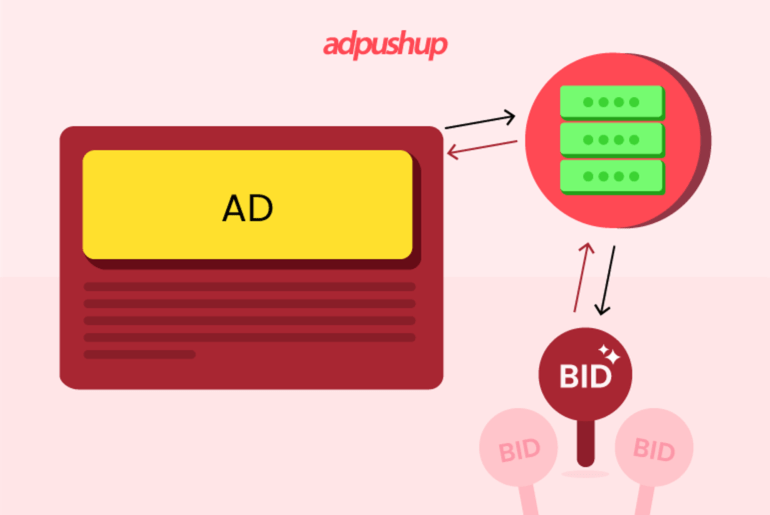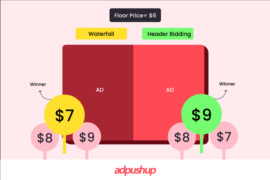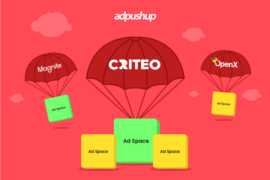Delve into the transformative influence of Server Side Header Bidding on programmatic advertising. Explore how this innovative technology is reshaping the industry, enhancing efficiency, and optimizing revenue streams for both publishers and advertisers.
In the world of programmatic advertising, the competition for ad impressions is fierce. With the widespread usage of programmatic advertising came better and efficient techniques, and one of them is server side header bidding.
Most publishers and advertisers have turned to server-to-server header bidding. This is because server side header bidding helps combat the primary issues of latency and page performance. It puts the auction into an external server-side platform instead of the client-side browser on the publisher’s website.
The technology allows connecting with servers for lightning-fast auctions and better transparency. It gives an equal shot at success for both publishers and advertisers.
What is Server Side Header Bidding
Server-side header bidding is a technique that enables ad buyers to bid on the ad inventory in real-time. It is also known as server to server header bidding or S2S header bidding.
The traditional method of header bidding involves loading JavaScript tags on the publisher’s website. And the server side header bidding eliminates the need for various tags. It connects the publisher’s ad server to the buyer’s ad server without any interruption and reduces latency.
In the next step, the publisher sends the ad requests to an external server. This server hosts a header bidding wrapper, which sends the requests to demand-side platforms. The DSPs then send their bid back to the wrapper, which selects the highest bid, and sends it back to the publisher’s ad server.
The recent global update related to the DSPs market shows that it is projected to reach USD 64487.0 Million by 2028 at a CAGR of 26.15%.
The winning bid is then displayed on the publisher’s website in real-time.
How Server Side Header Bidding Works?
The server side header bidding works on a server, which reduces latency and allows for more demand partners to participate in the auction. It involves several steps:
- A Publisher sends the ad request to an external server hosting a header bidding wrapper.
- The Wrapper sends the ad request to multiple demand-side platforms (DSP) .
- The DSPs receive and analyze the ad request to determine if they want to bid on the inventory.
- If the DSP decides to bid, it sends its bid to the header bidding wrapper.
- The wrapper receives the bids from the DSPs and selects the highest bid.
- The winning bid is then returned to the publisher’s ad server, which displays the ad on the website in real-time.
What’s Better, Sever-Side Header Bidding or Open Bidding?
There are two popular methods of conducting programmatic advertising auctions. The first one is server-side header bidding.
Server-to-server header bidding has become a popular method for programmatic advertising auctions. It allows for faster communication between servers which increases the number of bid requests.
The second one is open bidding which includes a larger number of demand partners, who bid on the client side in real time. This method allows for greater competition, transparency, and access to a wider range of demand sources.
Role of Demand Side Platforms in Server-to-Server Header Bidding
The demand-side platforms (DSPs) in S2S header bidding allow advertisers to bid on ad inventory in real-time. Also, the process of bidding for ad impressions occurs in the cloud which allows for more efficient and scalable bidding. DSPs are one of the most important processes, along with Supply Side Platforms and ad exchanges.
DSPs connect to the publisher’s ad server via API, rather than using a browser-based solution. It allows for faster communication between the two parties, which leads to a transparent auction process.
It is recommended that publishers work with an experienced ad tech partner or ad network to ensure proper implementation of S2S.
Check Here: What is a Demand Side Platform (DSP) and Why It Is Important for Publishers?
Server Side Header Bidding | Benefits for Publishers:
The top benefit of server-side header bidding is the ease of managing bids from different ad exchanges. It also allows us to determine the highest bid and then serve the winning ad for the user. There are several benefits including:
Increased Ad Revenue
Since server-side header bidding enables multiple DSPs to bid on inventory simultaneously, publishers can receive higher bids and increase their ad revenue.
Improved Ad Targeting
With server to server header bidding, DSPs can access data such as user behavior and demographics which they can use to target ads.
Reduce Latency
By eliminating the need for multiple javascript tags. It reduces the latency associated with traditional header bidding. It ensures that the ad impression is loaded faster, improving the user experience.
Greater Transparency
The server-side header bidding allows publishers and advertisers to see the actual bid placed by each DSP. This transparency helps both parties to make informed decisions about their ad campaigns.
Benefits for Advertisers:
In the server to server header bidding bids are processed on a server instead of a user browser, allowing for faster and more efficient ad serving. Here are some benefits of S2S header bidding for advertisers:
- The benefits of server-to-server header bidding provide greater transparency and improved ad targeting.
- With S2S advertisers can see the actual bids placed by each DSP. It’s allowing them to make more informed decisions about their ad campaigns.
- Also, by enabling DSPs to access more data, including user behavior and demographics, server-to-server header bidding can help advertisers target their ads more effectively.
- Server-to-server header bidding helps reduce ad fraud, as it provides a more secure environment for advertisers. This is because SSHB uses server-side auction technology that allows for more robust fraud detection and prevention measures.
- SSHB allows advertisers to access more data, such as first-party data, that can be used for better targeting. This can lead to more effective campaigns and higher ROI.
Challenges Associated With Server-Side Header Bidding
Being well-versed the benefits of S2S header bidding for both publishers and advertisers might have convinced you to switch. Bbut before making any decision, you should also know the downsides associated with server to server header bidding. Below, we have mentioned some challenges publishers may have to go through after applying S2S bidding.
High Cost
Setting up server side header bidding can be an expensive process that many publishers won’t be able to afford. While providing many benefits, S2S bidding can also lead to additional costs, which many new publishers will find it hard to go through. Partnering up with a vendor, applying new technologies and training are all actions which are expensive. These make it harder for publishers to completely switch to server-side header bidding.
Complex Setup
Even if publishers are able to handle the cost of switching, many end up failing when it comes to understanding the complex nature of server to server header bidding. This form of bidding requires integration with another platform and handling multiple bids from demand partners. The complex setup can be hard for some publishers to handle at first.
Latency Issues
The complex nature of server-side header bidding can also lead to latency issues. This is likely due to the errors publishers have made when setting up the header bidding wrapper and server overloads.
Reduced Visibility
Since S2S auctions are moderated by external vendors, publishers don’t have much control over the whole process, which results in reduced visibility. Compared to client-side header bidding auctions, where publishers can see much more information, SSHB auctions can be challenging.
Limited Ad Targeting
With cookies not being a factor in server-side header bidding, ad targeting gets more limited than client-side header bidding auctions. This can greatly affect ad personalization and revenue.
Knowing the problems you will be facing when switching to server-side header bidding auctions, now let’s discuss how you can handle these problems in the next section.
How Publishers Can Tackle These Challenges?
Choose the Right Vendor
With SSHB, the vendor you’ll partner up with greatly affects the overall environment and experience; that’s why it should be your utmost priority. Choosing the right vendor will automatically reduce the issues publishers will face later on and help maximize profit.
Demand Transparent Reporting
With auctions and bidding, there is a lot of data that can be used to improve as a publisher. Always ask for a detailed report from your vendor partner, this will help you handle issues and get insights into the bidding process.
Monitoring & Testing
After switching to S2S bidding, publishers should focus on monitoring their performance and keeping a check on all the issues that are limiting profit. After monitoring, publishers need to test different configurations to determine the optimal bidding setup.
Partner up with a S2S professional
Making the switch to server-side from client-side server bidding is no easy task. Publishers should always partner up with a reliable SSHB professional when making the switch. While anyone can learn how S2S bidding works in a short time, the experience can’t be gained that easy. That’s why it is always preferred to look for a partner who can help you fit in comfortably and make the process better.
Invest in training
Lastly, to handle the challenges in the world of server-side header bidding, publishers should invest in training their staff to be well-equipped. Whether it is knowledge or experience, a trained staff can make all the difference for a publisher. Doing this early on can help in minimising losses and ensure better yield management.
Challenges Associated with Client-Side Header Bidding
Browser Request Limitations
Header bidding in its original form is a client-side technology. It means that all the request calls needed to facilitate the ad auction are sent from and received by the user’s browser. The code resides and is executed within the header of the web page rendered on the browser.
This becomes a problem because browsers have a limit on how many calls they can send and receive concurrently.
For instance, Chrome will only make six requests per host and ten overall before it waits to issue new requests.
It puts a limit on how fast the auction can be executed, regardless of how many demand partners you add into the mix.
High Ad and Page Latency
Latency in client-side header bidding comes in many shapes and forms. It’s a significant improvement over the RTB waterfall setup, but the issue of latency still exists.
Limiting Response Times
In the client-side header bidding, demand partners have varying response times. The networks take time to respond to complete the server auction and impression. Such an incident could hold your entire ad operation hostage to the slowest network.
Auction Discrepancies
Discrepancies in client-side header bidding happen because of technical and speed constraints. It means exchange B will lose the bid to exchange A even if it places a greater first bid. The unified auction is the solution to this problem in S2S (Server to Server) bidding. It can make the end result less than optimal both for the publishers, who lose money, and ad exchanges, who lose the bid.
Server Side Header Bidding vs. Client Side Header Bidding in a Nutshell
Here are some pointers to elaborate on server-to-server and client-side header bidding:
- The major difference lies in where the bidding process takes place. In client-side header bidding, the auction takes place in the user’s browser.
- The publisher’s website loads multiple javascript tags from various demand-side platforms, which then compete in a real-time auction to serve an ad impression. The winning bid is sent back to the publisher’s website and the ad is displayed.
- In S2S header bidding the auction takes place on the publisher’s server. Instead of loading multiple javascript tags on the website, the publisher’s ad server communicates with the DSPs to receive bids.
- The ad server sends a request to all the DSPs simultaneously, collects the bids, and then sends the highest bid back to the website.
- The advantage of server-to-server header bidding is that it reduces the latency associated with client-side header bidding.
- Since all the bidding takes place on the server, there is no need to load multiple JavaScript tags on the website.
- It can slow down the page load time. This can improve the overall user experience and increase ad viewability.
- Server-side header bidding also allows publishers to access more demand sources since they are not limited by the number of javascript tags. This can lead to more competition among DSPs and potentially higher ad revenue.
Read More: Client-Side vs. Server-Side Header Bidding: What to Choose?
Key Highlights
To conclude, server to server header bidding is a programmatic advertising method to maximize ad revenue. By allowing multiple demand partners to compete for an ad inventory. The server-side header bidding creates a fair and transparent auction process.
Revenue growth and improved user experience are two main benefits of server-side header bidding. That makes it a worthwhile investment for publishers.
- The server to server header bidding allows for a fair and transparent auction that maximizes ad revenue for the publisher.
- It enables publishers to deliver a better user experience.
- It gives publishers and advertisers more control over the bidding process.
AdPushup header bidding solution enables publishers to open up their ad inventory for bidding by multiple demand partners in real-time. Get Started here.
Frequently Asked Questions
Yes, traditional header bidding requires additional infrastructure and technical expertise to implement. Publishers and advertisers must weigh the potential benefits against the cost before implementing S2S.
Implementing server-to-server header bidding can be technically complex and may require additional resources. Additionally, managing multiple demand partners and optimizing bids can be time-consuming and require specialized expertise.
It depends on various factors, including the size of your audience, the complexity of your ad stack, and your goals for revenue growth and user experience. Consulting with an expert will help you if server-to-server header bidding is the right solution for your needs.
There is no right answer to this, both server-side and client-side header bidding have their pros and cons that put them above each other in different scenarios. To determine which bidding method is right, publishers should evaluate their website and choose the most suitable one.
Yes, publishers can take the hybrid approach and run both server-side and client-side header bidding auctions on their sites.
Google Adsense uses the CPC (cost-per-click) method to pay publishers, while header bidding uses CPM (cost-per-impression) to pay publishers.
Yes, small websites can run server-side header bidding for their inventories. But, this isn’t advised as the profit margin for small businesses is limited with S2S auctions.

Deepak has a keen eye for detail and a deep understanding of the ad tech landscape. Whether it’s through in-depth articles, thought-provoking insights, or compelling storytelling, he’s dedicated to helping people navigate the complex world of ad tech with the simplicity of his words.







